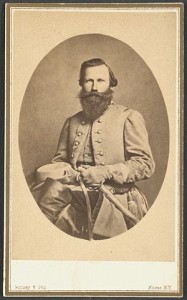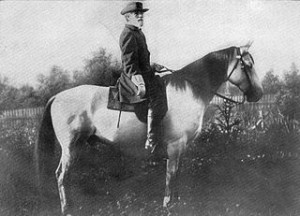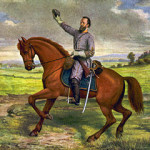The Civil War Song: Jine the Cavalry
J. E. B. Stuart’s Cavalry Adventures
The Civil War song: Jine the Cavalry, is a popular Civil War song about James Ewell Brown Stuart’s cavalry adventures.
The song includes verses about events such as the ride around the Army of the Potomac, and the Gettysburg Campaign. This song was the unofficial theme of James Ewell Brown Stuart’s cavalry corps and supposedly was a favorite of Stuart’s.
Do you want to catch the Devil?
Do you want to have fun?
Do you want to smell hell?
Bully boys, hey! Bully boys, ho!
JINE THE CAVALRY!
Here’s one for all you rebels out there.
Jine the Cavalry
From the 2nd South Carolina String Band’s Hard Road album.
CHORUS: If you want to have a good time, jine the cavalry!
Jine the cavalry! Jine the cavalry!
If you want to catch the Devil, if you want to have fun,
If you want to smell Hell, jine the cavalry!
We’re the boys who went around McClellian,
Went around McClellian, went around McClellian!
We’re the boys who went around McClellian,
Bully boys, hey! Bully boys, ho!
CHORUS: If you want to have a good time, jine the cavalry!
Jine the cavalry! Jine the cavalry!
If you want to catch the Devil, if you want to have fun,
If you want to smell Hell, jine the cavalry!
We’re the boys who crossed the Potomicum,
Crossed the Potomicum, crossed the Potomicum!
We’re the boys who crossed the Potomicum,
Bully boys, hey! Bully boys, ho!
CHORUS:
If you want to have a good time, jine the cavalry!
Jine the cavalry! Jine the cavalry!
If you want to catch the Devil, if you want to have fun,
If you want to smell Hell, jine the cavalry!
Then we went into Pennsylvania,
Into Pennsylvania, into Pennsylvania!
Then we went into Pennsylvania,
Bully boys, hey! Bully boys, ho!
CHORUS:
If you want to have a good time, jine the cavalry!
Jine the cavalry! Jine the cavalry!
If you want to catch the Devil, if you want to have fun,
If you want to smell Hell, jine the cavalry!
The big fat Dutch gals hand around the breadium,
Hand around the breadium, hand around the breadium!
The big fat Dutch gals hand around the breadium,
Bully boys, hey! Bully boys, ho!
CHORUS:
If you want to have a good time, jine the cavalry!
Jine the cavalry! Jine the cavalry!
If you want to catch the Devil, if you want to have fun,
If you want to smell Hell, jine the cavalry!
Ol’ Joe Hooker, won’t you come out of The Wilderness?
Come out of The Wilderness, come out of The Wilderness?
Ol’ Joe Hooker, won’t you come out of The Wilderness?
Bully boys, hey! Bully boys, ho!
CHORUS:
If you want to have a good time, jine the cavalry!
Jine the cavalry! Jine the cavalry!
If you want to catch the Devil, if you want to have fun,
If you want to smell Hell, jine the cavalry!


